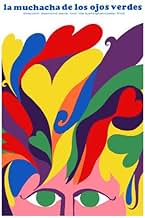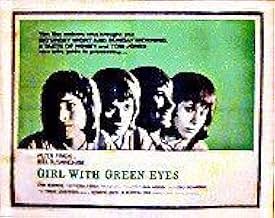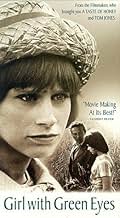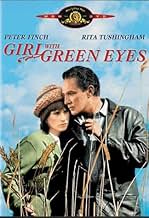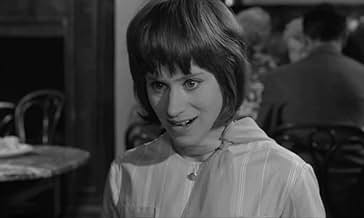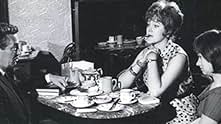NOTE IMDb
6,9/10
1,6 k
MA NOTE
Ajouter une intrigue dans votre langueIn 1960s Dublin a young girl becomes involved with an older man, a much-travelled and still-married landowner.In 1960s Dublin a young girl becomes involved with an older man, a much-travelled and still-married landowner.In 1960s Dublin a young girl becomes involved with an older man, a much-travelled and still-married landowner.
- Réalisation
- Scénario
- Casting principal
- Nomination aux 2 BAFTA Awards
- 3 victoires et 3 nominations au total
Marie Kean
- Josie Hannigan
- (as Maire Kean)
Liselotte Goettinger
- Joanna
- (as Lislott Goettinger)
Pat Laffan
- Bertie Counham
- (as Patrick Laffan)
Michael C. Hennessy
- Davey
- (as Michael Hennessy)
Joseph O'Donnell
- Patrick Devlin
- (as Joe O'Donnell)
Michael O'Brien
- The Lodger
- (as Micheal O'Briain)
David Kelly
- Ticket Collector
- (as Dave Kelly)
Avis à la une
It's just an episode but charmingly well done, Rita Tushingham shining with her eyes all through the film, well seconded by the slightly more reticent and laconic Peter Finch as the middle-aged writer with a failed family behind him and no illusions left, trying to be alone working by writing, which is difficult as Rita Tushingham keeps haunting him, and his family in America making themselves reminded by commenting on an aging man's relationship with a teenage girl with no experience - it could have been equivocal, but it isn't at all, since it is set in Ireland among angily bigotted catholics who also object against the unorthodox relationship and even try to do something about it by hard methods - there is some drama on the way. Lynn Redgrave assists Rita as well as she could and actually saves the situation in the end.
I saw this film when it was new, it was likeable enough already then, but made no lasting impression, wherefore I gave it a chance 50 years later just to refresh my memory and see what it really was all about - but it imported nothing new. It was still just an episode, charmingly well done, with the Rita's shining eyes and Peter's morose introversions - well done, indeed, but hardly universal, just local.
I saw this film when it was new, it was likeable enough already then, but made no lasting impression, wherefore I gave it a chance 50 years later just to refresh my memory and see what it really was all about - but it imported nothing new. It was still just an episode, charmingly well done, with the Rita's shining eyes and Peter's morose introversions - well done, indeed, but hardly universal, just local.
Girl with Green Eyes seems typical of the period of British "Kitchen-Sink" drama films (I saw it as the 2nd part of a double bill with The Leather Boys and the theme being Rita Tushingham performances, though this is dialed down a little from that turn), and that's what's good but not terribly memorable about it all. It's realistic in some of the basic character interactions, though it has a bouncier/more emotionally-cued up score than the material should have, if that makes sense. It seems like a minor point but Desmond Davis clearly wanted to get a lot of emotional/romantic/tragic pull out of the music by John Addison, and it may have been too much for this lot of realism (how typical this is by the way, it's produced by Tony Richardson).
The story is actually an Irish-Kitchen-Sink movie, though with a couple of British touches: a young girl in Dublin, who originally was from a fairly lower-class farm that was highly religious but working *very* Irish class all the same, is working at a bookstore and finds that there's an author that she would like to meet along with her friend/roommate Baba. Peter Finch is this man, and soon Kate, the girl of the title, takes a real liking to him, and after not too long he to her. So they "hook up", so to speak, and this brings on problems, both external in force (he's technically married with a kid in another country, she's got pressure from her family not to have anything to do with this "Godless heathen), and more about the fact that it's a man who could be old enough, if only barely, to be her father.
This is a story explored in many kind of films, whether it's throw-a-dart-and-hit a Philip Roth story, or of course Manhattan. There's enough chemistry and charm between the two leading people as Tishingham, even dialed down, is delightful, and Finch does a lot playing usually-crusty and mostly sardonic/sarcastic speaking (if there had been a remake some years back I could've seen Alan Rickman in his role), plus Lynn Redgrave being wonderful and funny in her supporting place. But there's not much here that elevates it past its time and place; it's a perfectly fine drama, and it doesn't distinguish itself past some insights, which are only insightful up to a point, that you may need to grow as a person (or can never meet the other on the flipside due to losing "youthful vigor" as an aging man) to have a relationship work sometimes.
There's a nice, tender feeling to the film, Finch and Tushingham make a good pair on screen (precisely because we kind of know, deep down, it's not only not going to work but it can't not ever work, if that makes sense, so let's see them in the little moments) and that should work for anyone looking for that. Although some things that contribute to the 'hasnt-aged-terribly-well' is, say, when the film is edited so early on in their courtship Eugene and Kate talk and one part of a sentence begins in a new location and then another and another, and it feels distracting.
The story is actually an Irish-Kitchen-Sink movie, though with a couple of British touches: a young girl in Dublin, who originally was from a fairly lower-class farm that was highly religious but working *very* Irish class all the same, is working at a bookstore and finds that there's an author that she would like to meet along with her friend/roommate Baba. Peter Finch is this man, and soon Kate, the girl of the title, takes a real liking to him, and after not too long he to her. So they "hook up", so to speak, and this brings on problems, both external in force (he's technically married with a kid in another country, she's got pressure from her family not to have anything to do with this "Godless heathen), and more about the fact that it's a man who could be old enough, if only barely, to be her father.
This is a story explored in many kind of films, whether it's throw-a-dart-and-hit a Philip Roth story, or of course Manhattan. There's enough chemistry and charm between the two leading people as Tishingham, even dialed down, is delightful, and Finch does a lot playing usually-crusty and mostly sardonic/sarcastic speaking (if there had been a remake some years back I could've seen Alan Rickman in his role), plus Lynn Redgrave being wonderful and funny in her supporting place. But there's not much here that elevates it past its time and place; it's a perfectly fine drama, and it doesn't distinguish itself past some insights, which are only insightful up to a point, that you may need to grow as a person (or can never meet the other on the flipside due to losing "youthful vigor" as an aging man) to have a relationship work sometimes.
There's a nice, tender feeling to the film, Finch and Tushingham make a good pair on screen (precisely because we kind of know, deep down, it's not only not going to work but it can't not ever work, if that makes sense, so let's see them in the little moments) and that should work for anyone looking for that. Although some things that contribute to the 'hasnt-aged-terribly-well' is, say, when the film is edited so early on in their courtship Eugene and Kate talk and one part of a sentence begins in a new location and then another and another, and it feels distracting.
This film is based upon the second volume of Edna O'Brien's "Country Girls" trilogy. That novel was originally published as "The Lonely Girl", but for some reason this was changed in the film adaptation to "Girl with Green Eyes", even though it was made in black and white so one cannot tell what colour the main character's eyes are. Subsequent editions of the book were also entitled "Girl with Green Eyes".
The title character is Kathleen "Kate" Brady, a naive young girl from the rural west of Ireland, who moves to Dublin, where she works in a grocer's shop and shares a room with her friend and schoolmate, Barbara "Baba" Brennan. (Baba is only a secondary character in "Girl with Green Eyes", but she plays a more central role in the other two episodes of the trilogy). Kate hopes to find a boyfriend, but she is shy and naïve and has less success than the more worldly-wise Baba. Eventually, however, Kate becomes involved with the middle-aged Eugene Gaillard, and it is their romance which forms the main subject-matter of the film. (In the original novel Eugene was a film-maker, but here he becomes a writer).
The age difference between Kate and Eugene is not the only obstacle in the way of their relationship. She is a devout Catholic and he a freethinker who does not share her faith. To make matters worse, he is married with a child. He is separated from his wife, but the two are not formally divorced. (At the period when the film is set, divorce was not possible in the Irish Republic; Mrs Gaillard, an American by birth, has had to return to her native country in order to obtain one). Kate's widowed father is horrified by the idea that his daughter is involved with a married man and he descends on Dublin with a group of friends, virtually kidnapping Kate and forcing her to return home, although at the first opportunity she can get she runs back to Eugene.
When the "Country Girls" trilogy was first published, between 1960 and 1963, it caused great controversy in O'Brien's native Ireland. It could be published in Britain but was banned in the Republic, and copies of the books were publicly burned. (It seems that the only freedom the Irish people had gained by secession from the UK was the freedom to be less free than their neighbours). It is therefore surprising that permission was given to make the film in Dublin and other Irish locations, even though it was made in 1964, only a hear after the final instalment in the trilogy had come out.
The film was, however, made by a British production company, Woodfall Film Productions, and the leading actors were all either British (Rita Tushingham as Kate, Lynn Redgrave as Baba) or Australian (Peter Finch as Eugene). Despite the Irish setting, it was made in the "kitchen sink" social-realist style popular in Britain in the late fifties and sixties. Woodfall had earlier made other films in this style, such as "A Taste of Honey", which also starred Tushingham, and "The Loneliness of the Long Distance Runner", both directed by Tony Richardson, who acted as executive producer for "Girl with Green Eyes". The director, however, was Desmond Davis, making his directorial debut after working as a cameraman. .
At the time, the "kitchen sink" school was hailed as marking a new departure in British film-making, although the vogue for films of this nature was to be a relatively brief one, and did not really survive into the seventies (not, by any means, the most distinguished decade in British cinema history). "Spring and Port Wine" from 1970 can be seen as marking the end of the line. Nevertheless, that brief period saw some films of genuine quality and gave a voice to the British working class who had previously been neglected by the country's film-makers.
There are first-rate performances from Tushingham as Kate, a much more sensitive and vulnerable figure than her Jo in "A Taste of Honey", and from Finch as Eugene, a rather more sympathetic figure than he is in the book, a sophisticated, intellectual type who is at first flattered by the attentions of a younger woman, but who realises that the differences between them are too great to be easily overcome. "Girl with Green Eyes" is perhaps less well-known today than films like "Saturday Night and Sunday Morning", "A Taste of Honey" or "The Loneliness...", but I think it deserves to be better remembered.
The title character is Kathleen "Kate" Brady, a naive young girl from the rural west of Ireland, who moves to Dublin, where she works in a grocer's shop and shares a room with her friend and schoolmate, Barbara "Baba" Brennan. (Baba is only a secondary character in "Girl with Green Eyes", but she plays a more central role in the other two episodes of the trilogy). Kate hopes to find a boyfriend, but she is shy and naïve and has less success than the more worldly-wise Baba. Eventually, however, Kate becomes involved with the middle-aged Eugene Gaillard, and it is their romance which forms the main subject-matter of the film. (In the original novel Eugene was a film-maker, but here he becomes a writer).
The age difference between Kate and Eugene is not the only obstacle in the way of their relationship. She is a devout Catholic and he a freethinker who does not share her faith. To make matters worse, he is married with a child. He is separated from his wife, but the two are not formally divorced. (At the period when the film is set, divorce was not possible in the Irish Republic; Mrs Gaillard, an American by birth, has had to return to her native country in order to obtain one). Kate's widowed father is horrified by the idea that his daughter is involved with a married man and he descends on Dublin with a group of friends, virtually kidnapping Kate and forcing her to return home, although at the first opportunity she can get she runs back to Eugene.
When the "Country Girls" trilogy was first published, between 1960 and 1963, it caused great controversy in O'Brien's native Ireland. It could be published in Britain but was banned in the Republic, and copies of the books were publicly burned. (It seems that the only freedom the Irish people had gained by secession from the UK was the freedom to be less free than their neighbours). It is therefore surprising that permission was given to make the film in Dublin and other Irish locations, even though it was made in 1964, only a hear after the final instalment in the trilogy had come out.
The film was, however, made by a British production company, Woodfall Film Productions, and the leading actors were all either British (Rita Tushingham as Kate, Lynn Redgrave as Baba) or Australian (Peter Finch as Eugene). Despite the Irish setting, it was made in the "kitchen sink" social-realist style popular in Britain in the late fifties and sixties. Woodfall had earlier made other films in this style, such as "A Taste of Honey", which also starred Tushingham, and "The Loneliness of the Long Distance Runner", both directed by Tony Richardson, who acted as executive producer for "Girl with Green Eyes". The director, however, was Desmond Davis, making his directorial debut after working as a cameraman. .
At the time, the "kitchen sink" school was hailed as marking a new departure in British film-making, although the vogue for films of this nature was to be a relatively brief one, and did not really survive into the seventies (not, by any means, the most distinguished decade in British cinema history). "Spring and Port Wine" from 1970 can be seen as marking the end of the line. Nevertheless, that brief period saw some films of genuine quality and gave a voice to the British working class who had previously been neglected by the country's film-makers.
There are first-rate performances from Tushingham as Kate, a much more sensitive and vulnerable figure than her Jo in "A Taste of Honey", and from Finch as Eugene, a rather more sympathetic figure than he is in the book, a sophisticated, intellectual type who is at first flattered by the attentions of a younger woman, but who realises that the differences between them are too great to be easily overcome. "Girl with Green Eyes" is perhaps less well-known today than films like "Saturday Night and Sunday Morning", "A Taste of Honey" or "The Loneliness...", but I think it deserves to be better remembered.
Poor Rita Tushingham--she did seem to inherit some strangely frustrating parts.
In "A Taste of Honey" she was a young pregnant girl, first abandoned by her itinerant sailor, then landing in a "relationship" with a sadly confused chap.
In "Girl with Green Hair," she's another adolescent who falls for a man twice her age. Won't she ever learn?
Director Desmond Davis' work resembles Tony Richardson's so much that their styles are almost interchangeable. It may be because Composer John Addison also scored Richardson's "A Taste of Honey," and "Loneliness of the Long Distant Runner." It's remarkable how Addison's bleakly dissonant style so greatly influences the moods of these dramas.
With Davis employing a lot of contrapuntal passages played by a thin woodwind ensemble--often featuring a solo oboe--one does feel the emptiness and loneliness of character emotions.
There was no one who embodied the "Cockney Kitchen Sink" dramas of the 60s like Tushingham. She was perfect for her parts. Here ably supported by Peter Finch as a blase older man and Lynn Redgrave as a daftly talkative friend, Tushingham plays her role to the hilt.
By the end, the viewer has come to experience a limited encounter--rather doomed from the start--between a worldly wise Dublin land owner and working class Brit girl . . . the latter of whom is finally able to move on with her education and find acquaintances more her age.
The viewer during this visit has experienced some telling scenes of Irish-English life, and an interesting adolescent/mature fling at a brief encounter.
In "A Taste of Honey" she was a young pregnant girl, first abandoned by her itinerant sailor, then landing in a "relationship" with a sadly confused chap.
In "Girl with Green Hair," she's another adolescent who falls for a man twice her age. Won't she ever learn?
Director Desmond Davis' work resembles Tony Richardson's so much that their styles are almost interchangeable. It may be because Composer John Addison also scored Richardson's "A Taste of Honey," and "Loneliness of the Long Distant Runner." It's remarkable how Addison's bleakly dissonant style so greatly influences the moods of these dramas.
With Davis employing a lot of contrapuntal passages played by a thin woodwind ensemble--often featuring a solo oboe--one does feel the emptiness and loneliness of character emotions.
There was no one who embodied the "Cockney Kitchen Sink" dramas of the 60s like Tushingham. She was perfect for her parts. Here ably supported by Peter Finch as a blase older man and Lynn Redgrave as a daftly talkative friend, Tushingham plays her role to the hilt.
By the end, the viewer has come to experience a limited encounter--rather doomed from the start--between a worldly wise Dublin land owner and working class Brit girl . . . the latter of whom is finally able to move on with her education and find acquaintances more her age.
The viewer during this visit has experienced some telling scenes of Irish-English life, and an interesting adolescent/mature fling at a brief encounter.
Desmond Davis, who had worked closely with Tony Richardson, decided to try his hand directing films. For his first effort he decided to use Edna O'Brien's novella "The Lonely Girl", which we read a long while ago, and frankly, we don't remember it well. The result was a movie that has that "English Look" of what came out of England during those years.
"Girl with Green Eyes" owes its success to Rita Tushingham, an actress that was the darling of English movie makers. She had a certain waif look that she used to her advantage in films such as this one, and in others of the same period. She holds the movie together as it's hard to take one's eyes from hers. Ms. Tushingham was not a spectacular beauty, yet she had a certain look that was appealing in her work.
Peter Finch appears as Eugene Gaillard, a man who is divorced with a child, and whose estranged wife has moved overseas. His attraction for Kate Brennan is quite understandable, yet, Eugene can't get Kate to be more than a platonic admirer, never being able to consume the passion she feels for him, and vice versa.
Also in the movie, a young and fresh Lynn Redgrave, who went to make bigger and better things on her own in the British cinema and on the stage and films in America, her adoptive country.
"Girl with Green Eyes" is worth a look for what Desmond Davis was able to accomplish in his first feature. The copy we watched recently was sadly in need of restoration.
"Girl with Green Eyes" owes its success to Rita Tushingham, an actress that was the darling of English movie makers. She had a certain waif look that she used to her advantage in films such as this one, and in others of the same period. She holds the movie together as it's hard to take one's eyes from hers. Ms. Tushingham was not a spectacular beauty, yet she had a certain look that was appealing in her work.
Peter Finch appears as Eugene Gaillard, a man who is divorced with a child, and whose estranged wife has moved overseas. His attraction for Kate Brennan is quite understandable, yet, Eugene can't get Kate to be more than a platonic admirer, never being able to consume the passion she feels for him, and vice versa.
Also in the movie, a young and fresh Lynn Redgrave, who went to make bigger and better things on her own in the British cinema and on the stage and films in America, her adoptive country.
"Girl with Green Eyes" is worth a look for what Desmond Davis was able to accomplish in his first feature. The copy we watched recently was sadly in need of restoration.
Le saviez-vous
- AnecdotesIn the montage of the girls getting ready for their dates near the movie's beginning, the 45 r.p.m. record is "Fell In Love On Monday" by Fats Domino, who is also the topic of the magazine article near the record.
- Citations
Malachi Sullivan: Ah, the milk of human blindness.
- ConnexionsFeatured in Talkies: Remembering Dora Bryan/Our Dora (2019)
Meilleurs choix
Connectez-vous pour évaluer et suivre la liste de favoris afin de recevoir des recommandations personnalisées
- How long is Girl with Green Eyes?Alimenté par Alexa
Détails
- Date de sortie
- Pays d’origine
- Langues
- Aussi connu sous le nom de
- La muchacha de los ojos verdes
- Lieux de tournage
- Wellington Monument, Phoenix Park, Dublin, County Dublin, Irlande(Kate & Eugene and later Kate & Baba go there)
- Société de production
- Voir plus de crédits d'entreprise sur IMDbPro
Box-office
- Budget
- 140 000 £GB (estimé)
- Durée1 heure 31 minutes
- Couleur
- Rapport de forme
- 1.66 : 1
Contribuer à cette page
Suggérer une modification ou ajouter du contenu manquant

Lacune principale
By what name was La fille aux yeux verts (1964) officially released in India in English?
Répondre

